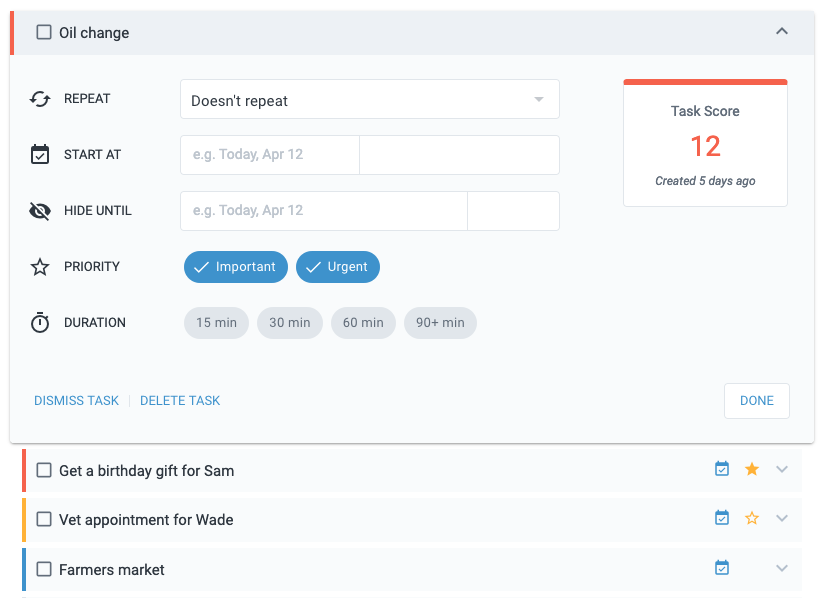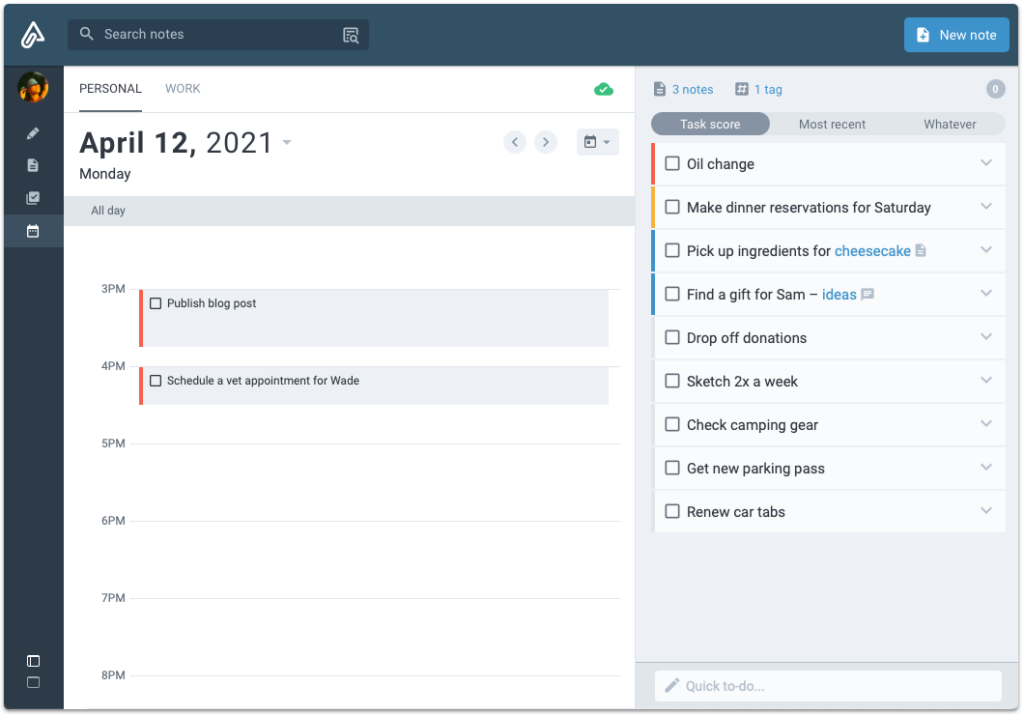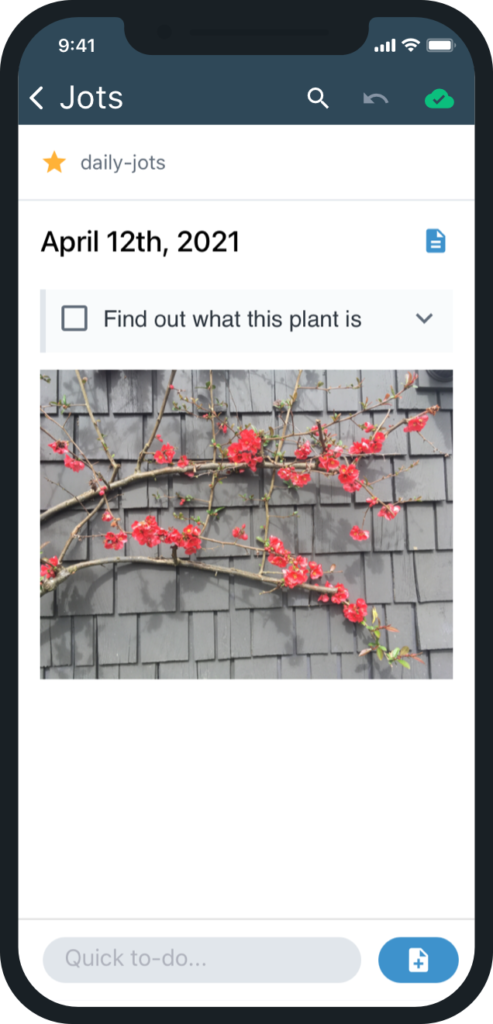Welcome to a new edition of our tools for thought series! We had the pleasure to chat with Bill Harding, one of the minds behind Amplenote, a note-taking app “to write things down and get them done.” Bill is the CEO of Alloy.dev, which builds productivity tools for busy people. Amplenote’s parent company of twenty currently oversees five websites, using Amplenote’s self-sorting, project-based to-do lists to keep everything under control.
Bill has been a programmer and entrepreneur since his early teens, when he launched his own bulletin board system to connect with local computer users before the Internet was invented. Bill went on to program Gameboy video games for a few years. He met his soon-to-be co-founder Jordan Phillips while creating a children’s game. All the while, Bill continued to pursue entrepreneurial side projects that pushed him to constantly experiment in a quest for the best to-do list.
Amplenote offers four modes of thinking: jots, notes, tasks, and a smart calendar. Flexible and cross-platform, it allows users to build on the knowledge of their past selves, to define their priorities, and to balance creativity with productivity. Among popular note-taking apps, Amplenote has distinguished itself in their effort to create the most efficient to-do lists.
In this interview, we talked about the tension between efficiency and serendipity, building an interconnected web of ideas, the factors that impact our decision-making process, the benefits of journaling, learning in public, and much more. Enjoy the read!
Thanks so much for joining us for this interview Bill! The first question I want to ask is: what inspired you to start building Amplenote? This is a very crowded space.
No kidding, there are hundreds of note taking apps already! I think a lot of people would say there doesn’t need to be another one. The main reason I started Amplenote with my co-founder Jordan was that we really wanted to see how far we could take the question: what would the best note-taking tool for productivity look like? How would that be different from the note-taking apps that exist today? So that was what set us down the path of building Amplenote.
We started to ask questions about those hundreds of note-taking apps on the market. Why were they all so bad at tasks, compared to an app like Todoist? Are they helping people be more creative, more organized? Why is it so often unclear if the company employees can read your notes? You could spend a lifetime exploring these questions.
People are usually working across a lot of different domains, with different projects, across their personal and professional life. Let’s say you’re a freelancer with 100% of your time under your control, and you want to spend it 40% on your main work project, 25% on learning, 25% on family, and 10% on exercise. All of those are different mental spaces that we inhabit, with specific tasks corresponding to each mental space.
How can you separate those tasks so that it’s really easy to jump between mental spaces? How can the app automatically feed you the best tasks for whatever project you’re most excited about this morning? There are always a hundred tasks to work on. What tasks are so bursting with opportunity that they deserve time and attention today? Is it possible to lead a life with fewer urgent tasks and more important ones? Those are the kind of questions I hope Amplenote can answer better than the rest of this crowded space.
I think it’s great that beyond product features, you have obviously spent a lot of time thinking about the ethos and the vision of the product. But how exactly are you helping people define their priorities and navigate all these different mental spaces?
It’s very contextual! I don’t know how many different kinds of productivity systems that I have dabbled with over the years, and I don’t think there is a perfect one. It depends on the mood of the particular day, what other people are expecting from you, and many other factors. That being said, I think there is science and history to lean on when trying to work out how we can help people smartly prioritize their life across all its contexts.
The answers to many of the best questions have been around for a long time. Tim Urban convinced me that the answer to the question “what to work on” has been around since at least the 1950s. It starts with the Eisenhower Matrix, with the idea of separating tasks into what is important and what is urgent. Then on top of that we sprinkle optional inputs, like whether the task has a specific deadline, how long it might take, and how often it has been previously considered?
Amplenote wants to combine people’s intuition with a proven framework for decision-making; then users can harness all of the wisdom and knowledge from their past selves to make smarter decisions as time passes.
Every day you open a task, you are going to see it through a different lens, with a tiny bit different perspective than the day before. That has been the secret behind the biggest successes I’ve had: start with an ok idea, keep improving it a little bit each day, until eventually it’s too good not to work on.
If the “perfect task prioritizing system” depends so much on context and mood, how can we build software flexible enough to accommodate that? One trick we use is to take a person’s past selves as a proxy for their enduring interest. We let a person’s past self from a week ago say: “I have determined that this task is important, so I will keep thinking about it. Help me find it again later, but not now.”
The best note taking app for productivity should present your juiciest tasks when you’re in the mood to work on them, and should help you get the best recurring ideas scheduled to your calendar so that you become consistently productive.
It’s interesting you are mentioning the idea of rediscovering your tasks and building on the knowledge of your past self. There is always a tension between being productive and making space for serendipity. It’s great to get into productive work mode, but you need a little bit of a playground to be creative.
The most useful kind of creativity is one that eventually manifests a product; one that turns creative energy into some kind of artifact that you and others can see. It doesn’t matter whether it takes a month or a year—now my idea is a website, tomorrow maybe a newsletter, or redecorating a space–whatever the outlet, it’s best if creativity becomes tangible, otherwise it’s just an idea. If “having ideas” is good, “having tangible results from those ideas” is even better. That’s why I think it makes sense for creative people to discover and pursue their productivity.
I think that on a day-to-day basis, the most creative and most effective people are the ones that don’t have a rigid schedule; the ones that can create large blocks of time to freely brainstorm and explore. Because it’s hard to predict when bursts of creativity will happen. You want a schedule that can flex back and forth between creative and productive energy.
Sometimes you just want to jot down freeform thoughts–that’s the first step of the Idea Execution Funnel. It’s a really creative, energizing mode of working. So get a fill of that to start the day, then work your way up to the fourth step of the Idea Execution Funnel, the newly launched Calendar. Once you’re on a roll getting tasks checked off, you can more easily make headway on the best, most important ideas that your past selves decided upon. The best productivity apps convert potential energy into action.
Absolutely, I agree it’s important to accommodate both of those, so users can oscillate between productivity and creativity. Talking about creativity, are there any use cases you didn’t expect?
Oh yeah! Honestly, we haven’t had much time to make content that recommends how users use the app. So, everyone kind of forges their own ideas about “how to best use this unusual combination of features” that Amplenote provides. To that end, we recently began encouraging users to make their own videos to share their use cases.
As far as specific surprises, one big one that stood out to me was the result from our user survey we started sending a few months ago. The respondents were like 90% in the “use a calendar every day” camp. I would have guessed that maybe 50% of note takers used a calendar daily? Apparently we’ve managed to attract a lot of users who, like us, live a mix of wanting to take notes and wanting to get things done.
The versatility of Daily Journaling has also been surprising. It wasn’t our first priority in the early days of the app, but we always listen to our users. People know what they want. So we’ve created a journaling mode for the app we call “Jots,” to help people write free of any structure except the date, which is automatically attached.
Journaling is often seen as a mindfulness tool, but it can definitely help with productivity. Can you tell us more about your own journaling practice?
It’s fascinating how much journaling has helped me generate momentum and clarify my thinking around the right mix of tasks for the day. Is this going to be the kind of day where I have big blocks of unscheduled time to be creative, or is it going to be a day where I work on urgent tasks? Journaling helps clarify these while leaving an artifact behind, which is a cool side benefit.
Like my to-do list practices, my daily journaling practices are constantly evolving. About half of the journaling I do ends up with a to-do list of some sort. But I also love to use journaling just to clarify thoughts and generate productive momentum at the start of a day.
We wrote a popular blog called Thinking in 3D to prove how ideas get sharper when written down. Daily journaling is a great way to sharpen ideas. When the journaling ends with realizing that I should take action, then I create tasks in the journal — which technically is a “note,” but viewed in “Jots” or journaling mode — and use the !move command to put it in a list to think about later.
Writing as a thinking tool! Beyond journaling, how do you personally use Amplenote?
My main use case is as a task manager. We have five different websites we maintain which means lots of important tasks to not forget about. But I also use Amplenote in my personal life: mainly to blog, also to keep personal goal lists, movies to watch, places to go… The usual stuff.
Amplenote has been especially helpful for me by being really quick to capture proto-ideas and make them better. Of course, oftentimes, I jot down bad ideas; the kind of ideas I thought might be interesting, but the clarity of the following day exposes them as rubbish. There are usually a few treasures mixed in with the trash though. When an idea becomes too good not to pursue, I will either start working on it straight away, or add it to my calendar if it’s for a project I already have a time block scheduled for. Amplenote has also been very useful when doing research on a topic. For instance, Rich Footnotes are extremely helpful for packing lots of information into a small space.
It’s great when founders actually love using their own product. But most of these sound fairly private, despite the fact that Amplenote allows you to publish your notes. What are your thoughts on working and learning in public?
This is such an important question. You should not be expected to have all the answers to a question when you first publish something! If you wait so long until you feel like you’re the expert on a particular topic, you are probably never going to publish anything, because it’s never going to feel quite polished enough for you. That’s why I think working and learning in public is awesome for people to publish content within domains in which they are still gaining expertise.
One of Amplenote’s goals is to make it as easy as possible for people to work and learn in public—constantly improving on their past ideas until they are as good as they possibly be. Hopefully people will realize Amplenote is a great tool for bloggers who want to escape the tyranny of WordPress.
I often think about musicians, and how they have to upper-case Publish a finished album. They have to decide exactly what each song is going to be before they release it to the public. But I bet there are a lot of musicians who would really much prefer if they could go back to their songs and make some edits a few months after they first released the album. They could change a couple of parts in a song, or maybe make the lyrics a little bit better. Of course, we are not at a point where it is possible just yet to do that for music, but it can absolutely work for writing.
One can only hope one day it will be possible for all types of creative work. What does the future look like for Amplenote?
We will help people become more productive and creative if they give us a shot. We want to help people answer questions like: what actually matters to me over the long-term? Not just today–what do you want to get done this year, or this decade? If we can help people take incremental steps towards living what started as their dream a year or a decade ago, we will have fulfilled our goal.
Thanks so much for your time, Bill! Where can Ness Labs readers learn more?
Our website is Amplenote.com, but many people discover us through Youtube. Shu Omi posted a great 17-minute review of Amplenote, and Scott Friesen also posted a great 9-minute summary of the Idea Execution Funnel. You can also follow us on Twitter or join us on Reddit. Thanks for creating the opportunity for this great conversation!



